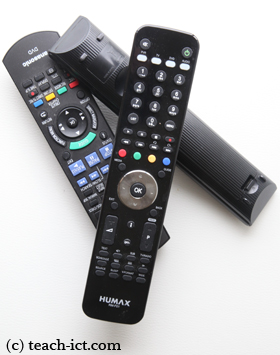2. Infrared communication (IR)
This is one of the earliest types of optical communication and is still very much in use today. It is found in remote controls for televisions, dvd players and most other entertainment devices.
Dimmer lights and other facilities can be also be controlled using infrared.
 Infrared uses light that is invisible to us and is just above the red end of the colour spectrum.
Infrared uses light that is invisible to us and is just above the red end of the colour spectrum.
The key component of an infrared system is an infrared LED (Light Emitting Diode) to emit the light and a photo-diode in the television or equipment to receive the light.
A digital code within the controller switches the light on and off, this is then picked up as a digital code at the other end. The communication standard is called 'IrDA' short for Infrared Digital Association and it allows wire-less communication between Mouse, keyboard, joysticks, gamepads etc and receiving equipment such as PC, Laptop, game console.
Bandwidth is normally quite modest, around 115.2 kbps (IrDA serial infrared standard). Although IrDA does define a fast data transfer standard of up to 14 Mbps, this is rarely used.
IR works only up to about 10 metres but that is fine for the type of applications it is mainly used for. It will only work line-of-sight.
Technologies such as Bluetooth has largely supplanted infrared as a communication method for mobiles and computers.
Advantages |
Disadvantages |
|---|---|
| Inexpensive compared to other technologies | Only works line-of-sight |
| Works over a moderate bandwidth 115 kbps | Short range - a few metres |
| Works well over a short distance | Low bandwidth |
challenge see if you can find out one extra fact on this topic that we haven't already told you
Click on this link: Infrared communication
